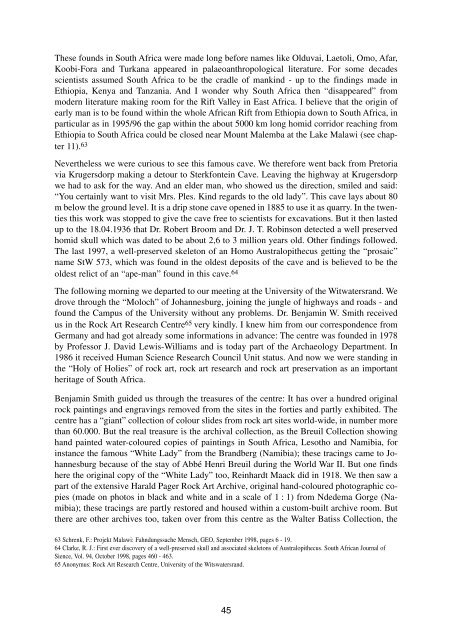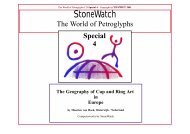1.) schw.weiss - StoneWatch
1.) schw.weiss - StoneWatch
1.) schw.weiss - StoneWatch
You also want an ePaper? Increase the reach of your titles
YUMPU automatically turns print PDFs into web optimized ePapers that Google loves.
These founds in South Africa were made long before names like Olduvai, Laetoli, Omo, Afar,<br />
Koobi-Fora and Turkana appeared in palaeoanthropological literature. For some decades<br />
scientists assumed South Africa to be the cradle of mankind - up to the findings made in<br />
Ethiopia, Kenya and Tanzania. And I wonder why South Africa then “disappeared” from<br />
modern literature making room for the Rift Valley in East Africa. I believe that the origin of<br />
early man is to be found within the whole African Rift from Ethiopia down to South Africa, in<br />
particular as in 1995/96 the gap within the about 5000 km long homid corridor reaching from<br />
Ethiopia to South Africa could be closed near Mount Malemba at the Lake Malawi (see chapter<br />
11). 63<br />
Nevertheless we were curious to see this famous cave. We therefore went back from Pretoria<br />
via Krugersdorp making a detour to Sterkfontein Cave. Leaving the highway at Krugersdorp<br />
we had to ask for the way. And an elder man, who showed us the direction, smiled and said:<br />
“You certainly want to visit Mrs. Ples. Kind regards to the old lady”. This cave lays about 80<br />
m below the ground level. It is a drip stone cave opened in 1885 to use it as quarry. In the twenties<br />
this work was stopped to give the cave free to scientists for excavations. But it then lasted<br />
up to the 18.04.1936 that Dr. Robert Broom and Dr. J. T. Robinson detected a well preserved<br />
homid skull which was dated to be about 2,6 to 3 million years old. Other findings followed.<br />
The last 1997, a well-preserved skeleton of an Homo Australopithecus getting the “prosaic”<br />
name StW 573, which was found in the oldest deposits of the cave and is believed to be the<br />
oldest relict of an “ape-man” found in this cave. 64<br />
The following morning we departed to our meeting at the University of the Witwatersrand. We<br />
drove through the “Moloch” of Johannesburg, joining the jungle of highways and roads - and<br />
found the Campus of the University without any problems. Dr. Benjamin W. Smith received<br />
us in the Rock Art Research Centre 65 very kindly. I knew him from our correspondence from<br />
Germany and had got already some informations in advance: The centre was founded in 1978<br />
by Professor J. David Lewis-Williams and is today part of the Archaeology Department. In<br />
1986 it received Human Science Research Council Unit status. And now we were standing in<br />
the “Holy of Holies” of rock art, rock art research and rock art preservation as an important<br />
heritage of South Africa.<br />
Benjamin Smith guided us through the treasures of the centre: It has over a hundred original<br />
rock paintings and engravings removed from the sites in the forties and partly exhibited. The<br />
centre has a “giant” collection of colour slides from rock art sites world-wide, in number more<br />
than 60.000. But the real treasure is the archival collection, as the Breuil Collection showing<br />
hand painted water-coloured copies of paintings in South Africa, Lesotho and Namibia, for<br />
instance the famous “White Lady” from the Brandberg (Namibia); these tracings came to Johannesburg<br />
because of the stay of Abbé Henri Breuil during the World War II. But one finds<br />
here the original copy of the “White Lady” too, Reinhardt Maack did in 1918. We then saw a<br />
part of the extensive Harald Pager Rock Art Archive, original hand-coloured photographic copies<br />
(made on photos in black and white and in a scale of 1 : 1) from Ndedema Gorge (Namibia);<br />
these tracings are partly restored and housed within a custom-built archive room. But<br />
there are other archives too, taken over from this centre as the Walter Batiss Collection, the<br />
63 Schrenk, F.: Projekt Malawi: Fahndungssache Mensch, GEO, September 1998, pages 6 - 19.<br />
64 Clarke, R. J.: First ever discovery of a well-preserved skull and associated skeletons of Australopithecus. South African Journal of<br />
Sience, Vol. 94, October 1998, pages 460 - 463.<br />
65 Anonymus: Rock Art Research Centre, University of the Witswatersrand.<br />
45
















